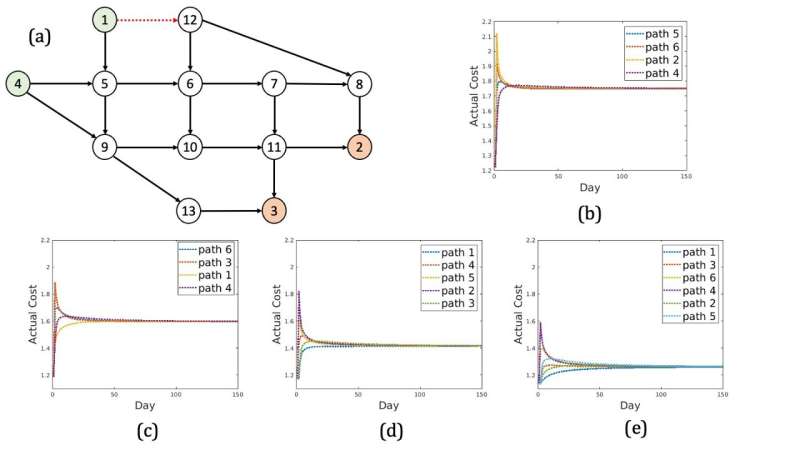A topology-based bounded rationality day-to-day traffic assignment model

A Communications in Transportation Research study suggests that individuals operate their travel choices influenced not only by the actual path travel costs but also by the topological similarity between them. In other words, if changing traffic conditions on a path leads a user to reconsider his travel choice, he will prefer shifting towards those paths most similar to the one he is abandoning. It is thus demonstrated that such preference implies a bounded rationality behavior.
Over the course of the last decades, transport systems have become increasingly complex and interdependent and simultaneously essential for our societies and economies. This makes them unpredictable and vulnerable to malfunctions, whose consequences can reverberate through the system for a long time while reaching areas that are quite far from the epicenter of the disruption. Among these systems, road traffic networks are probably the most striking example.
When a network is perturbed, i.e., when it experiences a significant change in demand or supply, congestion patterns shift and consequently some users end up on routes that have become more expensive (in terms of generalized costs) and are therefore motivated to switch in favor of less expensive ones. The present work analyzes the day-to-day adjustment process of users' behaviors in a transport network which is affected by relevant alterations. The model is a proportional-switch day-to-day discrete-time adjustment process which describes how, in a generic day, some users reconsider their travel choices considering their habits and biases.
Most adjustment models assume that users are perfectly rational, i.e., they make their decisions purely on the basis of objective evaluations aiming to maximize some utility function (or minimize a disutility function). On the contrary, there are many empirical studies in the literature which suggest that most of choice processes are subject to systematic approximations and errors where the experience of past iterations consolidated into habit has a significant influence on present choices. The field of transportation is no exception where imperfect rationality occurs in the form of shortest path violation.
In this model, habit is considered within users' route choice process by assuming that they make their decisions based not only on the objective network congestion state but also on the degree of topological similarity between the routes potentially improving their condition and the one they are currently using. Then, the perceived cost of a given route at a given time is not unique but relative to the type of user considering it. The more the route currently used by a given user overlaps with another, the lower will be the inertia to leave the first in favor of the second.
In addition to this sort of "spatial inertia," a "temporal inertia" is also introduced. If, following a switch, the travel cost for the users has decreased significantly, it is more likely that a smaller proportion of users will decide to change routes again, convinced of the improvement already achieved this is because they tend to overestimate the goodness of a route if, when using it, they suddenly experience a significant reduction in travel time compared to what they are used to.
In this paper, it is formally demonstrated that such choice behavior implies that a system's stationary point must necessarily correspond to a Boundedly Rational User Equilibrium (BRUE). The classical User Equilibrium (UE) is a state where flow patterns are arranged on the network in such a way that each user is unilaterally unable to further reduce his or her travel cost/time. This necessarily implies that all the routes used are at minimum cost.
At a BRUE, on the other hand, all routes whose travel cost/time is not greater than the minimum for more than a certain threshold are also used, as users are insensitive to excessively minute variations in cost or time. This threshold is often represented by means of an indifference band. In the present work, a method is proposed to estimate the indifference band for the users of each origin-destination pair based on the extent to which the paths overlap once the weight their topology has within the decision process is established.
More information: Enrico Siri et al, A topology-based bounded rationality day-to-day traffic assignment model, Communications in Transportation Research (2022). DOI: 10.1016/j.commtr.2022.100076



















